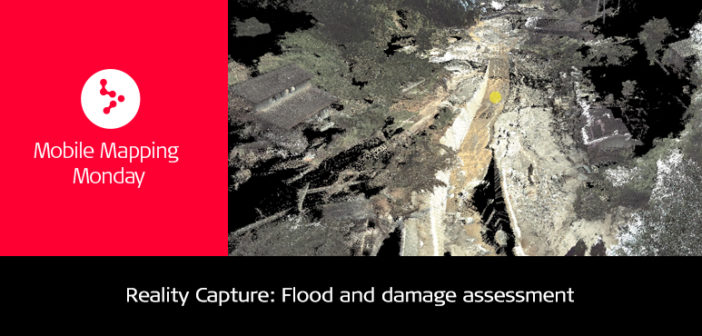Devastating flash floods occurred in the northern part of Kyushu, Japan on July 5th 2017. During the disaster, 37 people lost their lives and four were reported missing. The flooding damaged more than 1,400 houses and inundated about 1,600 houses in Fukuoka and Oita Prefectures (Figure 1). The disaster was triggered by a severe storm with more than 80 centimetres of rainfall in a short amount of time.

Figure 1: Flash flood affected area in Northern Kyushu in July 2017
To understand the hazard characteristics, the Disaster Prevention Research Institute of Kyoto University asked us to conduct post-disaster surveys. Our mission was to measure the positions and levels of flood marks in the affected areas, while the team worked, they kept fellow citizens in their thoughts. The Ministry of Land, Infrastructure, Transport and Tourism, a ministry of the Japanese government, would use this information to organise post-disaster activities.
Typically flood marks have been measured with a scale directly in the field. In recent years, to measure the exact positions and absolute levels of flood marks, RTK-GPS has also been used. In either approach, we have to measure flood marks one by one, which requires significant time and effort of the surveys.
To advance the post flood surveys, we tested the use of mobile mapping systems. In particular, we used the Leica Pegasus:Backpack mobile mapping solution to inspect inaccessible areas along small tributaries.
Post flash flood survey with Pegasus:Backpack
We conducted the survey on September 12, 2017 focusing on the Shirakitani River, a tributary of the Chikugo River in Fukuoka Prefecture. Our survey team was composed of just two people (Takahiro Sayama-the first author and an expert from Leica Geosystems Inc) (Figure 2). We walked along the stream for about 15 kilometres from the downstream to the midstream. It took only 12 hours to collect the data and an overnight to process it.

Figure 2: Post flash flood field survey on September 12, 2017 (photography by Mr. Ishida at Hokkaido University)
Measurement of maximum flood inundation depths from the images
The continuous 3D images were used to estimate the positions and levels of flood marks. The images were clear enough to identify flood marks (Figure 3); we identified 12 flood marks in total. The operation is as simple as just clicking flood marks on the software to find their positions.

Figure 3: Measurement of maximum inundation depths from Pegasus:Backpack image
Detection of topographic change by Pegasus:Backpack
The flash floods completely alter the topography of floodplains due to massive sedimentation caused by landslides. Flood inundation simulation also suggested the impact of topographic change from flooding. Without considering the topographic change, the simulation underestimated the inundation extent (Figure 4a).

Figure 4a, 4b: Flood simulation by the Rainfall-Runoff-Inundation Model
(a: with original topography, b: with altered topography)
The 3D images taken with the Pegasus:Backpack (e.g. Figure 5) were used to create the Digital Elevation Model (DEM) for the altered topography. The image shows the change of elevations caused by this event. Some places show more than 4 metres of sediment deposition, which agreed with the actual conditions as shown in the pictures (Figure 6). DEMs for the level of flooding have recently been taken from airborne data. Based on this study, DEMs from the Pegasus Backpack data was found to more accurately support the flooding models vs DEMs from the airborne data.

Figure 5: 3D image taken with Pegasus:Backpack
The flood simulation with the new DEM suggested the significant improvement of flood inundation extent (Figure 4b). The team also compared the inundation depths at the 12 locations in simulation to the same measurements by our survey.

Figure 6: The estimation of topographic change on the floodplain
Effective instrument for post disaster survey
This study showed the effectiveness of Pegasus:Backpack for post disaster surveys. For this flash flood case, we could estimate the positions and levels of flood marks efficiently as well as the topographic changes. By using Pegasus:Backpack, the surveyor can concentrate on just taking images, and later the team can focus on the detailed measurements based on the images. The taken images can be archived as an important record of a disaster.
There are many other potentials of the use of the instrument for other types of disasters such as earthquakes, volcanos, landslides, etc., due to the uniqueness of Pegasus:Backpack of its portability.
By Takahiro Sayama – Disaster Prevention Research Institute, Kyoto University, Japan and Yuji Kuwano – Leica Geosystems, Inc.














